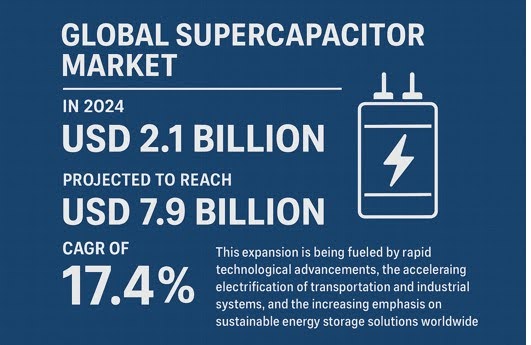The global supercapacitor technology market is experiencing significant expansion, driven by the increasing demand for efficient, high-performance energy storage solutions across various industries. Supercapacitors, also known as ultracapacitors or electrochemical capacitors, offer unique advantages over traditional batteries, including rapid charge-discharge cycles, high power density, and exceptional cycle life. These attributes make them critical for applications requiring quick energy bursts, such as regenerative braking in electric vehicles (EVs), power stabilization in renewable energy systems, and backup power in consumer electronics and industrial automation.
Market Overview
In 2024, the global supercapacitor market was valued at approximately USD 2.1 billion and is projected to reach USD 7.9 billion by 2032 growing at a compound annual growth rate (CAGR) of 17.4%. This expansion is being fueled by rapid technological advancements, the accelerating electrification of transportation and industrial systems, and the increasing emphasis on sustainable energy storage solutions worldwide.
Key Drivers of Growth
The accelerating shift toward electrification across industries is the most fundamental driver. Governments and businesses are prioritizing energy storage technologies that enable efficiency, resilience, and sustainability. Automakers are rapidly integrating supercapacitors into electric and hybrid vehicles for functions like regenerative braking, start-stop systems, and peak load support. Industrial players are adopting supercapacitors in cranes, robotics, and uninterrupted power supply (UPS) systems to enhance performance and reduce downtime. Consumer electronics and IoT devices are also benefiting from the ability of supercapacitors to deliver instant bursts of power and extremely fast charging.
Technological breakthroughs in graphene, carbon nanotubes, and hybrid electrode materials are further expanding application boundaries. Growing investments in renewable energy integration, including grid balancing and frequency regulation, make supercapacitors indispensable to global energy transition goals.
Regional Insights
North America continues to dominate the global supercapacitor technology market, accounting for nearly 43.14% of total share in 2024, supported by strong R&D infrastructure, established automotive leaders, and government policies promoting clean transportation. The U.S. and Canada are spearheading the integration of supercapacitors into EVs, aerospace systems, and renewable projects. Europe follows closely, particularly in Germany, France, and the Nordic nations, where stringent emission regulations and renewable energy targets are accelerating adoption across automotive and grid applications. Asia-Pacific, however, is the fastest-growing region, driven by China, Japan, South Korea, and India, where rapid industrialization, urban electrification, and government-backed smart city projects are fueling large-scale deployments.
Material Innovations
The material segment of the supercapacitor market is dominated by carbon-based electrodes, particularly activated carbon, due to their high surface area, affordability, and commercial maturity. These materials remain the backbone of electric double-layer capacitors (EDLCs) used in automotive, industrial, and consumer applications. However, advanced materials such as graphene and carbon nanotubes (CNTs) are redefining the performance landscape by offering superior conductivity, mechanical strength, and energy storage capacity, making them central to next-generation supercapacitors.
Challenges and Restraints
High production costs, particularly for advanced electrode materials like graphene and ionic liquids, continue to limit large-scale commercialization. Energy density remains lower than lithium-ion batteries, restricting supercapacitors to niche or hybrid applications rather than full-scale battery replacement. Supply chain vulnerabilities, especially for activated carbon and advanced nanomaterials, present risks to cost stability. The need for new standards and regulatory frameworks around safety, recycling, and integration into existing power systems also adds complexity.
Future Outlook
The future of the global supercapacitor technology market is exceptionally promising, with projections indicating strong double-digit growth through 2034. As electrification deepens across mobility, industry, and energy infrastructure, supercapacitors will move from being supplementary to becoming core enablers of next-generation systems. Their convergence with batteries in hybrid architectures is expected to unlock new performance thresholds, delivering both high power and higher energy efficiency.
Innovations in electrode and electrolyte chemistries will continue to improve energy density, paving the way for broader consumer electronics and grid-level adoption. While luxury and premium automotive currently dominate demand, the next phase of expansion will focus on cost-competitive solutions for mass-market EVs, urban mobility, and distributed energy storage.


